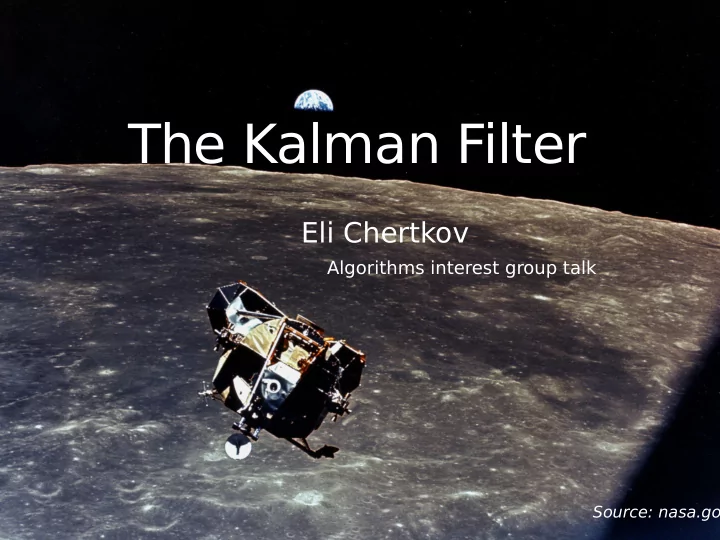

The Kalman Filter Eli Chertkov Algorithms interest group talk Source: nasa.gov
Some history of fjltering A central problem in signal processing is fjltering , fjnding a signal in noise Source: Wikipedia The Wiener Filter was proposed by Norbert Wiener and Andrey Kolomogorov independently in the 1940’s. Wiener worked on applying the fjlter to the automatic aiming of anti-aircraft guns in World War II. The Wiener Filter was designed for fjltering continuous, stationary signals.
Some history of fjltering The Kalman Filter is an extension of the Wiener Filter to non- stationary (and usually discrete) signals. Rudolf Kalman developed the Kalman Filter in the 1960’s. The fjlter was used to help control spacecraft navigation systems. It was even used in the NASA Apollo missions to the moon! Source: https://plus.math s.org/content/und erstanding-
The problem the Kalman Filter solves The goal of the Kalman Filter is to estimate the time evolution of a system, whose dynamics obey a linear stochastic fjnite-difgerence equation Process noise State Current state of Control to Control (driving transition Previous system state forces) matrix system state conversion matrix This estimate is based on measurements , which are linearly proportional to the system’s state Noise is assumed to be Gaussian distributed. Measurement Conversion System state Measuremen noise matrix t
Sketch of derivation of Kalman Filter equations The Kalman Filter algorithm involves iteratively computing a Gaussian estimate for the current state based on 1) previous estimates and 2) measurements . 1) Compute prediction from previous estimates Estimated mean Covariance of process Estimated noise covarianc e These equations come from inserting the equation of motion into defjnitions of mean and covariance. 2) Combine with current measurements where is the Kalman gain. These equations come from adding process and measurement Gaussians together and completing the square.
Example: Simple Harmonic Oscillator We all know the ubiquitous simple harmonic oscillator and its equation of motion: The SHO equation is a second-order linear ODE. We can write it as a system of fjrst-order linear ODEs. We can now discretize the ODEs with fjnite-difgerences to obtain Now we can apply the Kalman Filter.
Example: Simple Harmonic Oscillator Suppose that we have a SHO subject to random perturbations whose position we can measure with a noisy measuring device. How well can a Kalman Filter pick up the signal?
Example: Launching a satellite into orbit Suppose that we are a telecommunications company that wants to launch a satellite into geosynchronous orbit. We know the equations of motion of the satellite under the infmuence of gravity. Source: They are (in polar coordinates) http://www.space.com/19593- amazing-rocket-launches-photos- 2013.html These are non-linear! Does the Kalman Filter apply? Yes! We can linearize it at each time step by computing the Jacobian. Then we can use fjnite-difgerences as before. This non-linear fjlter, which combines Jacobians with the Kalman Filter is called the Extended Kalman Filter. Great, but what about the control parameters? How do we pick them?
Digression: PID control Proportional-Integral-Derivative (PID) control is a simple, general purpose control scheme. The control signal (driving force) has three separate terms, each of which attempts to force the system state into a target state Proportional control Integrated control Derivative control where is there error.
Example continued: Launching a satellite into orbit Using PID control along with the Kalman Filter, we can guide a satellite from launch to a geosynchronous orbit, even with a noisy measuring apparatus. Sketch of the result
Thank you! You can fjnd example scripts implementing the Kalman Filter in the ipython notebook posted on the group github.
Recommend
More recommend